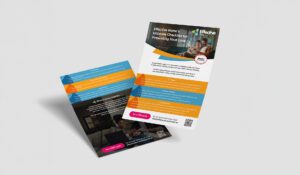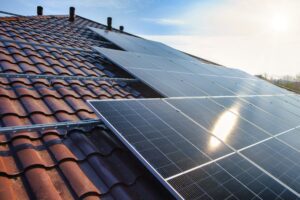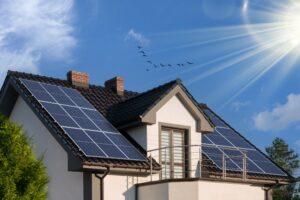There are many factors to consider before installing solar panels on flat roofs. Many people don’t realise that angles and orientations are important when putting together a flat roof solar system as the roof angle determines how efficiently you can convert daylight to energy.
Does this mean a flat roof system won’t work or is unsuitable? Let’s find out!
Here we discuss everything you should know about installing solar systems on flat roofs. Read on to learn the advantages and disadvantages, and discover the key differences between solar panels on a flat roof vs a pitched roof.
Can You Put A Solar Panel On A Flat Roof?
Yes, in the majority of cases you can put solar PV panels on a flat roof without any issues. Most modern buildings in the UK now have flat roofs, and it’s possible to install solar panels on them. However, there are some differences between solar systems on flat roofs versus sloped roofs.
Solar PV panels laid flat on the roof would operate with a much lower level of efficiency. Engineers solve this issue by mounting the panels on metal frames at an angle – using what is known as solar panel mounting systems. With the right adjustments, you can make flat roof solar panels work efficiently – potentially even more effectively than on a sloped roof structure.
A solar panel installation of this type is always best carried out by industry experts who understand the sun’s location and correct solar panel angles to achieve the best results. At Effective Home, we can design solar panel systems for flat roofs that work optimally to provide domestic properties and commercial buildings with solar energy sufficient for their needs.
- Create a Tailored Quote Based On Your Circumstances
- Takes Less Than 2 Minutes
- Fixed-Online Quotes

7 Things You Should Know Before Installing Flat Roof Solar Panels
Do you want to install solar panels on your flat roof? Here are seven things you need to be aware of before you make the decision to do so!
1. Orientation Matters
The sun is constantly on the move. It rises from the east and circles the sky until it sets in the west. Its position along the horizon also changes depending on where you are in the world and the time of year. It matters because sun rotation affects how much energy you are able to harvest with solar panels!
Don’t worry. The good news is you can account for this by changing your solar panel’s orientation. So what’s the best position for solar panels?
Panels facing the east or west are thought to be around 20% less efficient. For optimal power production in the UK, the solar panels on your home ideally should be south facing.
2. Pitch Adjustments Are Necessary
On top of orientation, there’s an ideal pitch for solar panels as well. For those with flat roofs, it’s a must to use solar mounting frames to allow your panels to rest at an angle that’s suitable for catching the daylight they require to generate energy.
During the summer, the sun rises higher above the horizon. In this case, a lower-angled solar panel is best.
On the other hand, a vertically inclined panel is more efficient in the winter. Plus, the angle increases the farther you are from the equator.
There are solar panels with adjustable pitches available. If you have an adjustable frame, you can change the angle of your solar panels throughout the year to best suit the time of year, though a 35° angle is considered the most efficient on average, if you would prefer to set up your panels on a flat roof and then leave them alone.
3. Factor Water In
Pitch is not only useful for increasing efficiency. It can lessen water complications as well.
Did you know that rain is a problem for flat roof installations when flat roof systems do not involve a mount?
Without a proper pitch, water can’t slide off. This means mounting a solar panel directly to a flat roof can lead to pooling, so solar panels installed on a flat roof will need special consideration.
You must prevent water from collecting on solar panels as it can cause irreparable damage. Installing draining devices on flat roof solar panels is a great solution, but changing the angle also works.
4. Think About Maintenance
In general, solar panels are self-cleaning. Whenever it rains, the water droplets effectively wash the majority of dirt and dust away.
It’s worth noting that a solar panel system on a flat roof may need more frequent cleaning, maintenance, and repairs. If you have a setup with a low pitch, rain may pool instead of rinsing the panels. As a result, you may need to manually wash your setup from time to time to keep your solar PV modules in good order and check for signs of pooling in poor weather.
5. Consider Wind Speed
Wind can be an issue for solar PV systems for flat roofs. This is because they aren’t laying close to a surface as is the case for panels installed on tilted roofs.
For people with flat roofs, you should ask professionals about the right panel size, tilt, and spacing to combat wind. In most cases, you must use weights to prevent the panels from getting blown off the roof. Having a stable metal frame helps as well.
We can help determine how solar panels on a flat roof would work for you and your property when you work with Effective Home for installation of your new panels
6. Remember to Account for Weight
Ballasts are heavy materials that add to the balance and stability of the solar panels. They’re essential to flat roof setups as they counter the weight of the angled panels.
You can use sand, gravel, or cement to steady your panels without making roof penetrations. Metal frames are also great for a sturdier mounting system.
Sadly, there’s a downside to using ballasts and metal frames. Your roof has a weight limit, and it may not have the capability to support excess weight – look into this and ensure you have a suitable roof warranty to account for your new, heavy installation, too.
7. Know That Prices May Vary
Are flat roof systems always more expensive? While it is true that the mounts, drainage solutions, and extra structural supports can add to the cost of your new solar system, you might also need to repair your roof so it is able to support the weight of the system.
Because of this, flat roof solar panels can often be more expensive. Of course, the price still varies depending on your circumstances. On the plus side, it’s safer and simpler to set up than solar panels on sloped roofs as you don’t need the same level of equipment to install them.
- Create a Tailored Quote Based On Your Circumstances
- Takes Less Than 2 Minutes
- Fixed-Online Quotes

Are Solar Panels for Flat Roofs Efficient? The Pros and Cons
Yes, they can be just as efficient as those on tilted roofs. However, you must adjust the pitch, orientation, and ballasts.
Below, we discuss the advantages and disadvantages of solar panels for flat roofs.
Advantages of Solar Panels for a Flat Roof
These are the perks of solar panels for flat roofs!
| Flexibility | You don’t need to worry about inefficient orientations and roof angles. Having a flat roof means you can build solar panels in any position. |
| Appearance | It’s harder to see flat roof solar panels from the ground. They’re more discreet, and there are no unsightly utilities. |
| Easy Installation | You can build flat roof solar panels without the need for complicated scaffolding. As long as you have good roof access, installation is easy! |
Disadvantages of Solar Panels for a Flat Roof
Here are some reasons you may not want to install flat roof solar systems:
| Dirt Accumulation | Researchers found that flat roof solar panels are more likely to have dirt build up. Dust and droppings from birds can build up and cause severe losses in energy output if not properly maintained and cleaned. |
| Space Issues | Flat roof solar panels need more space than those on tilted roofs. The panels are often further apart, so they don’t cast shade on each other, so you’ll need a large enough flat roof to accommodate the panels you need for an effective solar system. |
| Wind Instability | Solar panels on tilted roofs get screwed directly onto the tiling. Meanwhile, you need ballasts and mounts for those on flat roofs, increasing the cost, but further protecting your panels. |
What Do You Need to Install Flat Roof Solar Panels?
Do you want to have solar panels but have a flat roof? Here’s what you may need before installation!
A Home Survey
Home surveys are crucial for solar panel installations. This is when experts come to your home to check where you want the solar array installed.
Our team of professionals will measure your roof, conduct shade analysis, and gather structural information. Your electrical system will be assessed as well.
Through a survey from Effective Home, you can find out if it’s possible for you to have solar panels installed and how much it is likely to cost.
Information on Government Grants
You may be surprised to learn that solar panels are more affordable than ever! There are UK government grants and incentives for those willing to install solar panels.
What’s more, you don’t have to pay for a solar system in one go. There are flexible plans available, and you get a return on your investment over time through the electricity bill savings you make.
Don’t forget to check your eligibility for these programmes. You should ask your solar provider for the best payment plans.
Expert Advice
Having a solar system installed can get overwhelming at first and you are likely to have many questions. Many factors influence the efficiency of a setup.
Luckily, you’re not alone! You can get expert advice on the best approach for each step of the whole process.
There’s no need to worry about the pitfalls of installing solar panels yourself. With our help, you can start saving on electricity bills without worry!
Flat Roof Solar Installation Conclusions
Do solar panels on flat roofs work? The simple answer is yes, they do!
Although there are a few disadvantages, solar panels for a flat roof can be as effective as those on a tilted roof. In some cases, they’re even better since you can control the exact direction and pitch.
This means you shouldn’t let a flat roof stop you from getting solar panels for your home. Know that with a few adjustments, you can get a high-output system that saves you money in the long run!
- Create a Tailored Quote Based On Your Circumstances
- Takes Less Than 2 Minutes
- Fixed-Online Quotes




